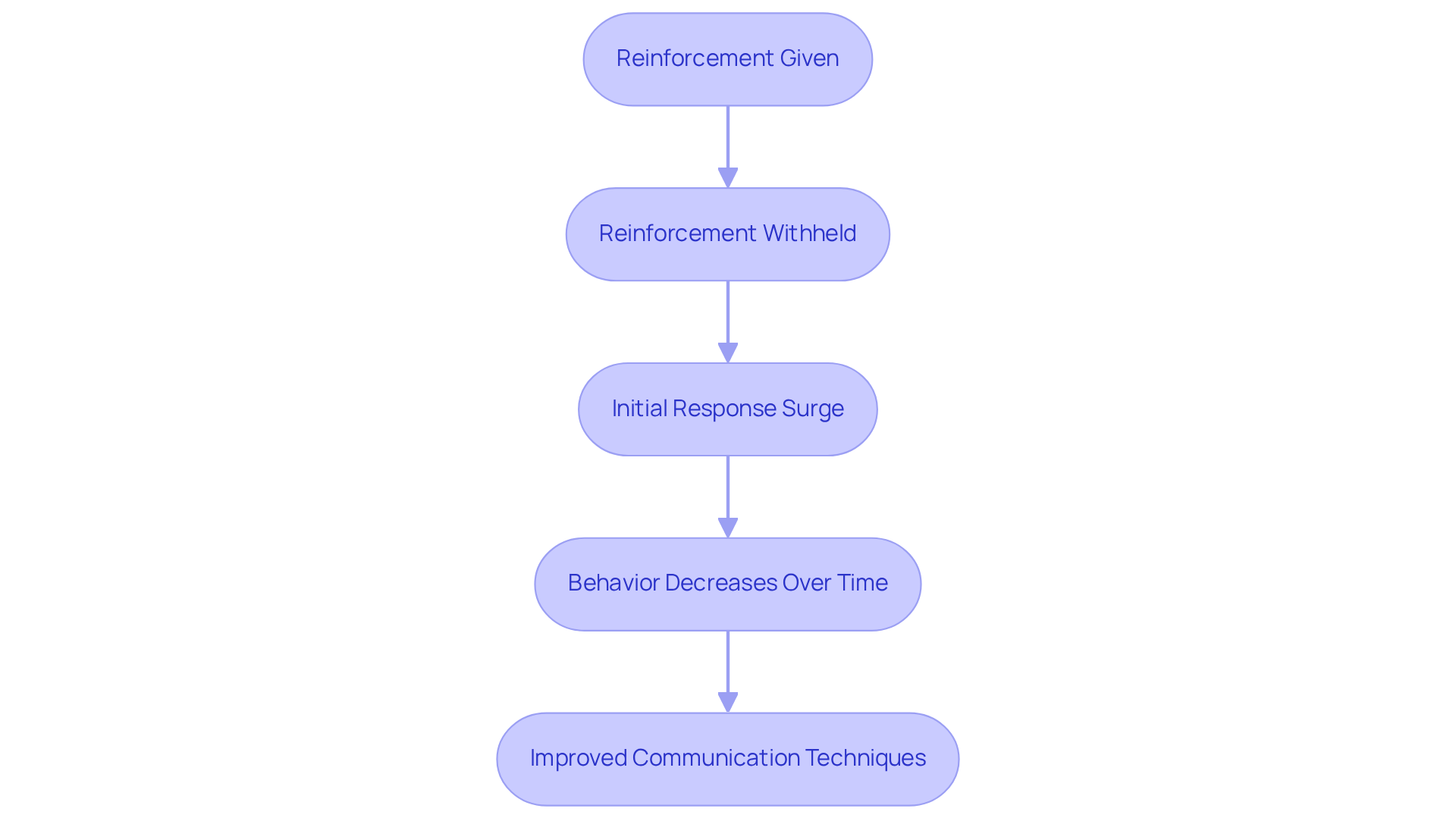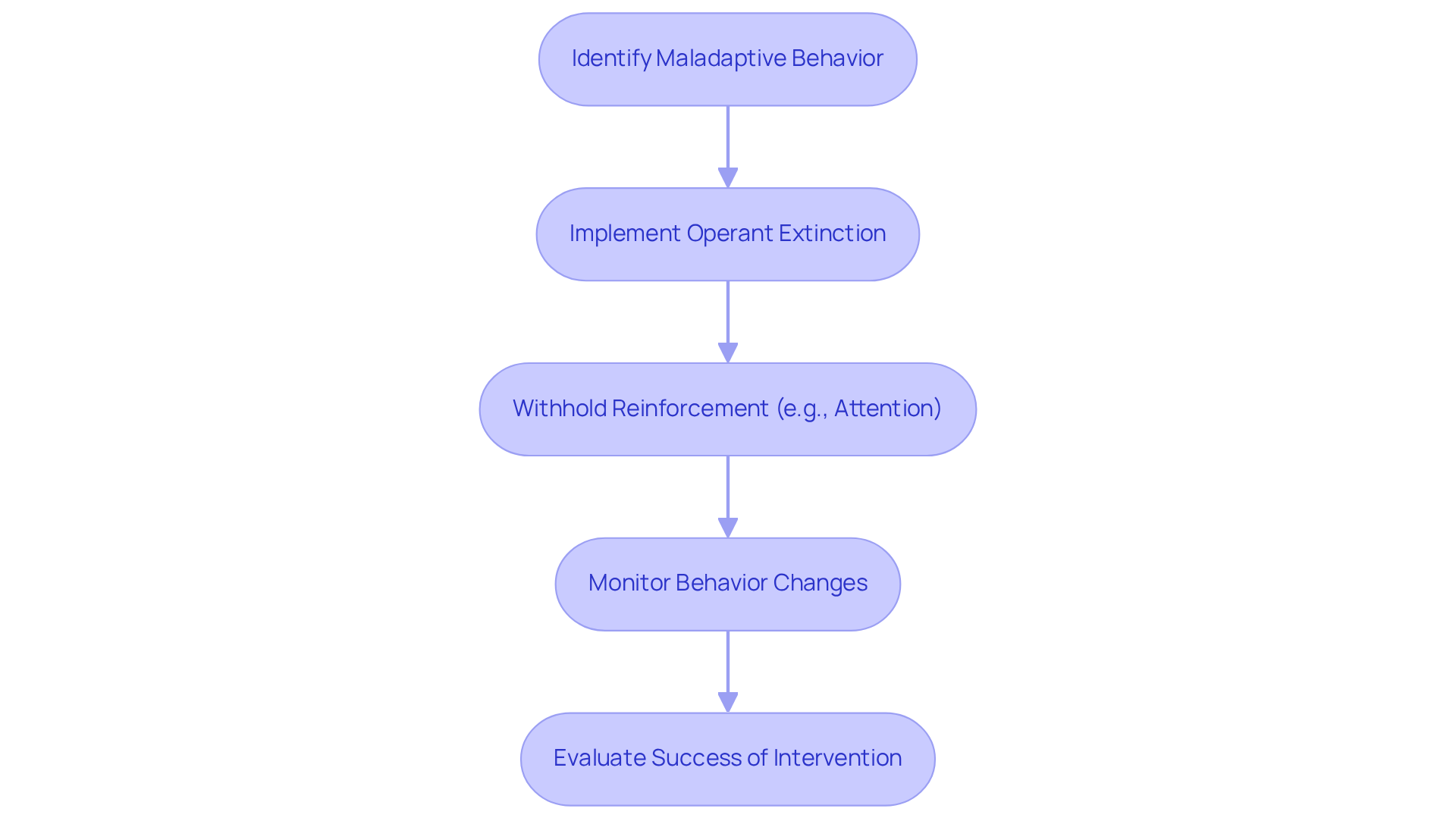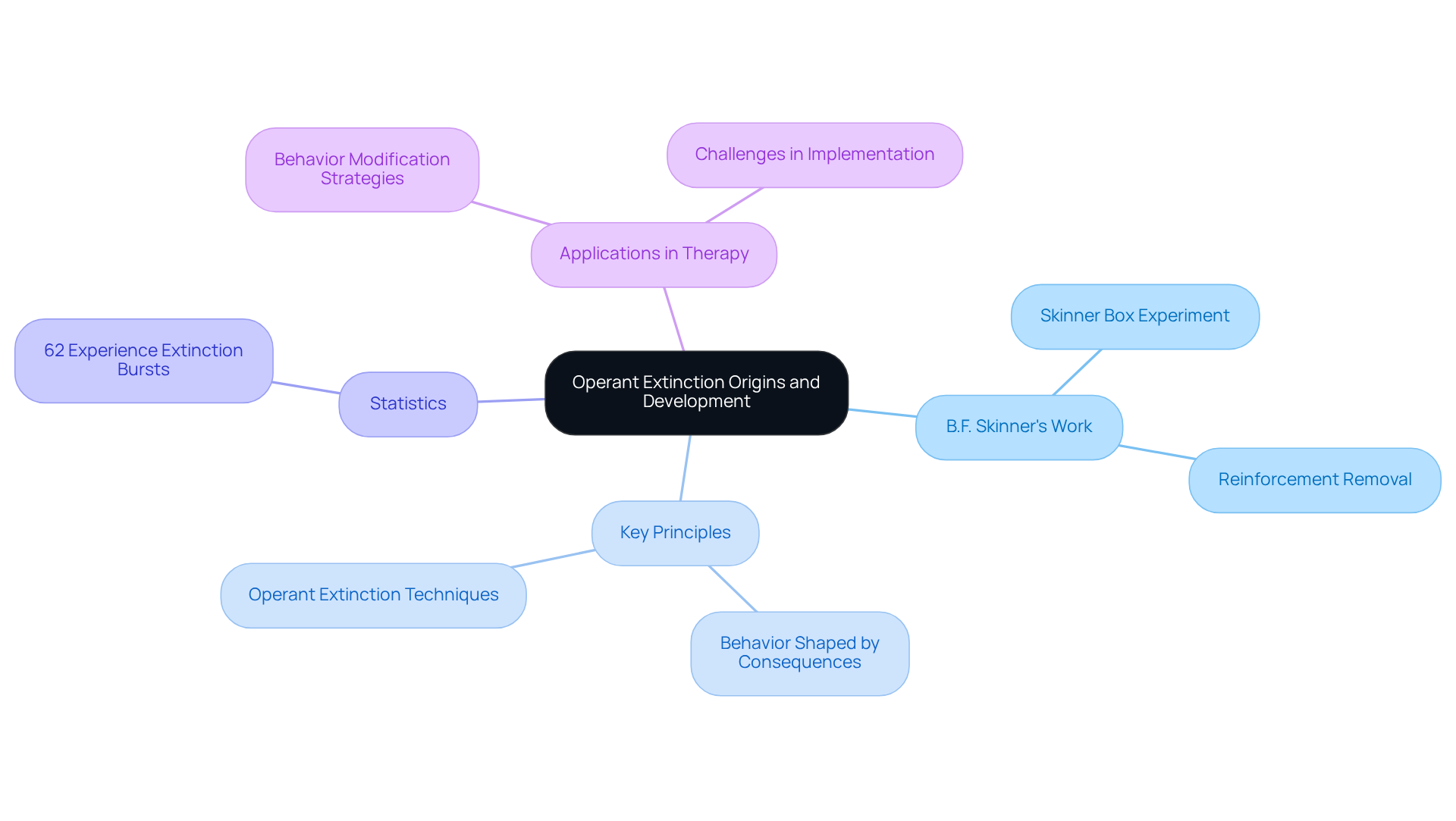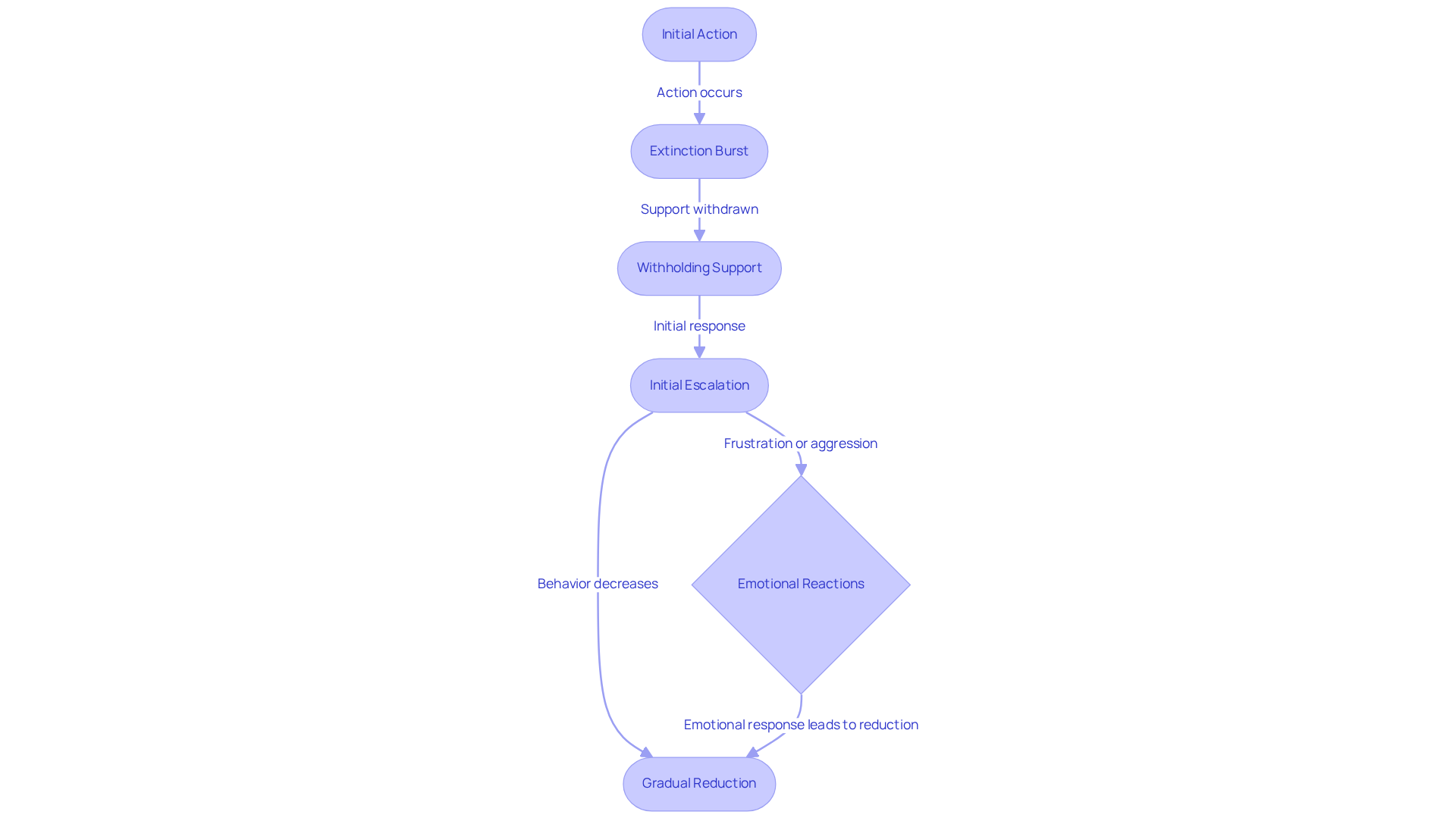June 26, 2025

Operant extinction in ABA therapy represents a critical process aimed at diminishing previously reinforced behaviors. This is achieved by systematically withholding reinforcement, resulting in a gradual decrease in those behaviors over time.
The article effectively illustrates this concept through various examples and research findings. Notably, it highlights the initial response surge that may occur prior to the decline of these behaviors, reinforcing the necessity of consistency in applying extinction techniques for successful behavior modification.
The escalating demand for Board Certified Behavior Analysts (BCBAs) underscores an urgent necessity for professionals who are adept in the complexities of Applied Behavior Analysis (ABA) therapy. At the heart of this expertise lies the concept of operant extinction, a potent technique employed to reduce behaviors that were previously reinforced by rewards. As practitioners navigate the intricate landscape of behavior modification, they face the challenge of effectively implementing this strategy—particularly in light of the potential for initial response surges that can complicate the process.
How can a deeper understanding of the mechanisms of operant extinction empower BCBAs to facilitate enduring behavioral change in their clients?
The demand for Board Certified Behavior Analysts (BCBAs) is projected to rise by 25% by 2026, underscoring the critical need for expertise in the field of Applied Behavior Analysis (ABA) therapy. A key aspect of this expertise lies in understanding the process of operant extinction, which is vital for diminishing or removing behaviors that were previously reinforced by withholding reinforcement. When an action that once received rewards no longer does, its frequency tends to decrease over time. For example, if a child is praised for saying 'please' but subsequently stops receiving that praise, they may eventually cease using the word altogether. This phenomenon is rooted in the principles of operant conditioning, where the outcomes of actions significantly impact future behavior.
Research indicates that the application of elimination can lead to noticeable alterations in behavior. When reinforcement is systematically removed, actions often experience an initial rise in frequency, known as a response surge, before gradually decreasing. Fisher et al. observed disappearance surges in five of six applications, highlighting the complexities of behavior modification, as individuals may initially respond more intensely when faced with the absence of expected rewards.
Real-world applications of operant reduction are evident in diverse settings, including educational environments and therapeutic practices. (FCT), for instance, promotes alternative communication techniques while withholding reinforcement for problematic behaviors, resulting in significant decreases in those actions. Statistics reveal that such function-based treatments can reduce problem behavior by 90% or more compared to traditional methods.
Understanding the principles of operant extinction is essential for professionals in ABA therapy, as it informs strategies for effectively modifying behavior and enhancing overall therapeutic outcomes. As the demand for BCBAs continues to grow, a solid grasp of operant behavior reduction will be increasingly vital in this expanding field. Are you prepared to meet this growing need with the right talent? Consider how Hire ABA can help you recruit the experts necessary to navigate these challenges.

Operant extinction serves as a fundamental method in (ABA), often utilized alongside reward strategies to effectively address maladaptive behaviors such as tantrums and aggression. This method operates using operant extinction by eliminating the reinforcement that underpins these actions.
For instance, when a child throws tantrums to gain attention, consistently withholding that attention during such episodes can lead to a significant decrease in the frequency of tantrums over time. Research indicates that when reduction is implemented correctly, it can yield substantial improvements in behavior management.
In fact, studies reveal that the success rates of operant procedures in diminishing maladaptive behaviors can be notably high, with certain interventions achieving significant reductions in problematic actions. This method is crucial for establishing organized environments where positive behaviors are consistently reinforced, while unhelpful habits are systematically diminished, ultimately fostering a more conducive atmosphere for learning and growth.

Operant unlearning stands as a cornerstone in behavioral psychology, rooted in the groundbreaking work of B.F. Skinner during the early 20th century. Skinner's innovative research on conditioning, particularly exemplified by his iconic Skinner Box experiment—where a rat received a food pellet for pressing a lever—illustrated how actions can be shaped by incentives and consequences. His findings laid the groundwork for understanding the impact of operant extinction on behavior, leading to the formal recognition of reinforcement removal as a vital behavioral strategy.
This evolution has been significantly influenced by various studies in clinical settings, where the demand for effective modification techniques has surged. Notably, research indicates that a substantial percentage (62%) of individuals undergoing therapy for maladaptive behaviors experience extinction bursts. This statistic highlights the complexities inherent in the effective application of .
Skinner's profound insights into the relationship between actions and their outcomes resonate in his assertion: "An individual's actions are shaped by the consequences of those actions." This principle continues to guide modern practices in Applied Behavior Analysis (ABA) therapy, underscoring the enduring relevance of Skinner's contributions to the field. Are you navigating challenges in understanding these behavioral dynamics? Embracing Skinner's principles can enhance your approach, fostering more effective interventions.

Key traits of operant extinction include:
Mechanistically, when support is withdrawn, actions may initially escalate as individuals strive to recover lost support. Research indicates that termination surges typically persist for about a week before actions begin to diminish. Notably, were found to be lower with 6 pellets compared to 1 pellet, highlighting can affect actions during the reduction phase.
However, with the consistent application of elimination techniques, actions will ultimately decrease. Practitioners must remain vigilant regarding the emotional reactions that may arise during this process, as individuals might exhibit frustration or aggression prior to the reduction in actions. Understanding these dynamics is essential for effectively managing the elimination process within therapeutic environments.
Case studies, such as the 'Impact of Consistency in ABA Therapy,' demonstrate that maintaining consistency across diverse contexts enhances skill generalization for individuals with autism, underscoring the importance of a structured environment in facilitating change. Additionally, parents and caregivers play a pivotal role in managing outbursts outside of therapy sessions, reinforcing the collaborative aspect of conduct management.
By understanding the mechanisms of operant extinction, practitioners can navigate the complexities of behavior modification more effectively in therapeutic settings.

Understanding operant extinction is essential for professionals in Applied Behavior Analysis (ABA) therapy. As the demand for skilled Board Certified Behavior Analysts (BCBAs) continues to rise, mastering this concept is crucial. Operant extinction plays a critical role in modifying behaviors that are no longer reinforced. By systematically withholding reinforcement, actions that were once rewarded can be diminished or eliminated, leading to more effective behavior management strategies. This approach not only enhances therapeutic outcomes but also cultivates an environment conducive to learning and growth.
The article highlights several key insights into operant extinction, including:
Have you considered how these strategies can significantly reduce maladaptive behaviors, such as tantrums? Real-world applications demonstrate that embracing operant extinction promotes positive behavioral changes across various settings.
Ultimately, understanding and applying operant extinction are vital for behavior analysts and other professionals working with individuals exhibiting challenging behaviors. Tailored interventions can lead to transformative results in fostering positive behavioral development. As you navigate the challenges faced in behavioral therapy, equipping yourself with knowledge of operant extinction will be crucial. Consider how Hire ABA can assist you in recruiting the right professionals to address these needs effectively.
What is operant extinction in ABA therapy?
Operant extinction is a process in Applied Behavior Analysis (ABA) therapy where previously reinforced behaviors are diminished or removed by withholding reinforcement. When an action that once received rewards no longer does, its frequency tends to decrease over time.
How does operant extinction work?
When reinforcement is systematically removed, the frequency of the behavior often experiences an initial increase, known as a response surge, before gradually decreasing. This effect highlights the complexities of behavior modification.
Can you provide an example of operant extinction?
An example of operant extinction is when a child is praised for saying 'please' but then stops receiving that praise. As a result, the child may eventually cease using the word altogether.
What are the real-world applications of operant extinction?
Operant extinction is applied in various settings, including educational environments and therapeutic practices. For instance, Functional Communication Training (FCT) promotes alternative communication techniques while withholding reinforcement for problematic behaviors, leading to significant reductions in those actions.
How effective are function-based treatments in reducing problem behavior?
Function-based treatments can reduce problem behavior by 90% or more compared to traditional methods, demonstrating the effectiveness of operant extinction strategies in behavior modification.
Why is understanding operant extinction important for BCBAs?
Understanding the principles of operant extinction is essential for Board Certified Behavior Analysts (BCBAs) as it informs strategies for effectively modifying behavior and enhancing overall therapeutic outcomes.
Our expert recruitment strategies and AI-driven sourcing ensure that you receive top-notch candidates quickly, without compromising on quality. Whether you’re looking for BCBAs, Clinical Directors, or RBTs, we’ve got you covered.